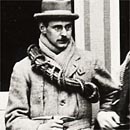William Douglas Mountaineer
William Douglas / Mountaineer
- Name : Douglas
- Born : 1863
- Died : 1932
- Category : Mountaineers
- Finest Moment : First Ascent Naismith's Route, Crowberry Ridge
An Edinburgh man, Douglas joined the newly formed SMC in 1890 and immediately became one of its most energetic and likeable characters. Only two years after joining that club he took over the post as Journal Editor, a task he performed diligently for 18 years from 1892-1909. Having married Phyllis Procter in 1908, he probably found that family life was taking up too much time and energy for such a time-consuming job!
As a mountaineer Douglas was very experienced, having climbed, between 1895 and 1912, in Switzerland, the Dolomites, France and Italy, the Canadian Rockies, Norway and the Jura Mountains. One of his most notable climbs was a 21-hour traverse of the Meije, with J Rennie, a fellow club member. It was of this climb, in the classic book by Raeburn "Mountaineering Art" that Raeburn asserted it was one of the few Alpine routes for which a rope was probably useful. As a climber, wrote his friend Rennie, Douglas was bold, but not rash and willing to take a chance.
In Scotland his ascents ranged over a wide area from the Southern Highlands to the far North-West. On Ben Nevis he has a permanent memorial as the 700-foot Douglas Boulder is named after him. This rock feature lies at the foot of Tower Ridge and in 1896 on an Easter Meet of the SMC at Fort William, four climbers made an ascent of the Very Difficult Direct Route on the Boulder. The party consisted of William Douglas (who in an amusing account of the climb referred to himself as the "baggage"), William Brown, who led the crux pitch, Lionel Hinxman and Harold Raeburn, who made an early appearance as a guest on the meet.
It was a mark of Douglas' popularity that the Boulder be named after him; even his photographs indicate his good nature. Lord Mackay, writing descriptions of some of the earlier climbers, describes Douglas as "always modest but indispensable". At his wedding, the cake was designed in the shape of a mountain, with climbers wielding ice axes dotted about its surface.
Other ascents on which Douglas played a key role included: Naismith's Route on Crowberry Ridge on the Buachaille. This was climbed in August 1896 and as Naismith later remarked, one of the most difficult parts of the day was in getting Douglas past the ripe clumps of crowberries growing everywhere. It was the first ascent of the formidably appearing Crowberry Ridge; Black Spout Gully, Left Branch (March 1893) and the first recorded ascent on Lochnagar. The day before this ascent, they made an incredibly bold attempt on a formidable gully further left on the cliffs, only to retreat before the 60m headwall. This was only climbed in 1950 and is now a grade 5. In their honour it is called Douglas Gibson Gully.
Douglas was interested in every aspect of the Scottish hills and he wrote 50 or so articles or notes on their topography, history, ornithology and other aspects. He was one of the first climbers to describe the Brocken Spectre in Scotland and included along with his note a delightful little sketch of the phenomenon.
William Douglas died in 1932, leaving his wife and two sons. Phyllis, who was also a keen climber, became one of the original members of the Ladies Scottish Climbing Club.
